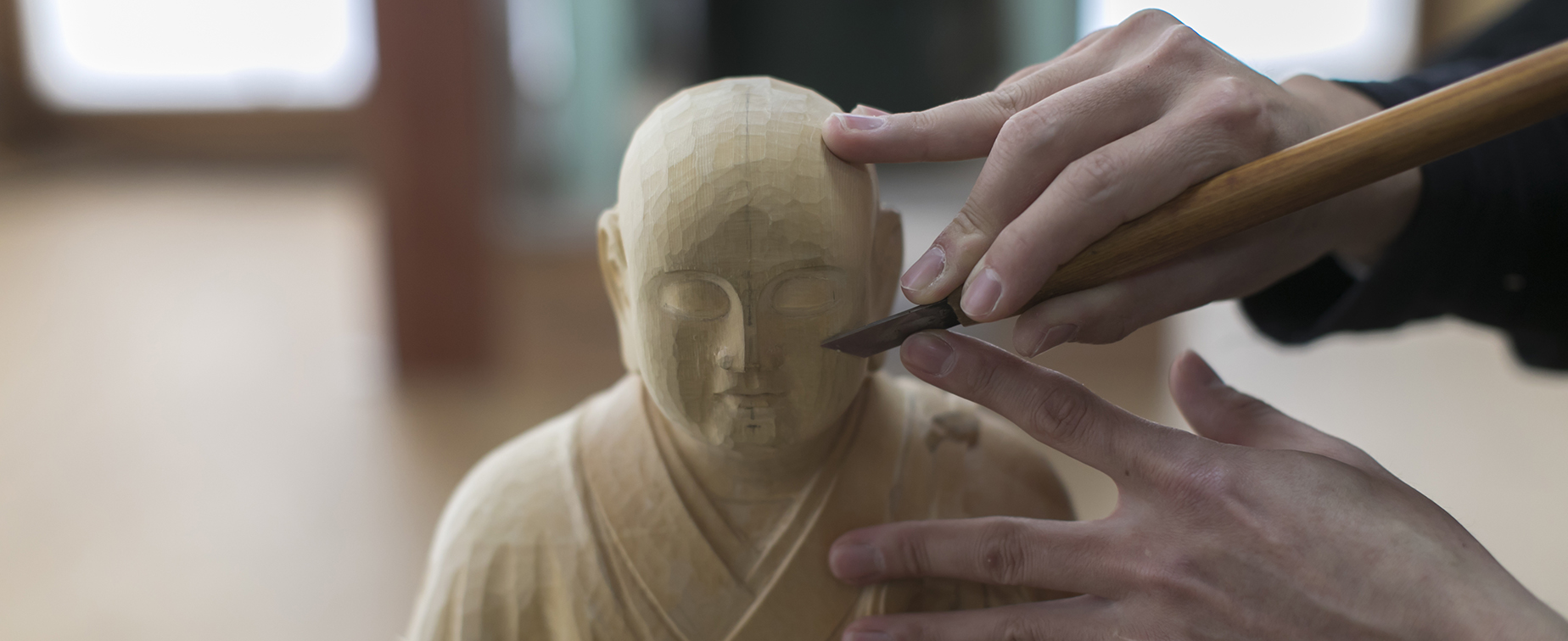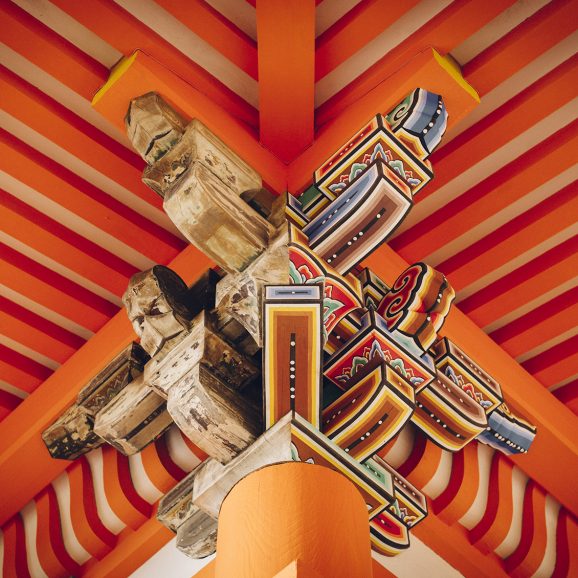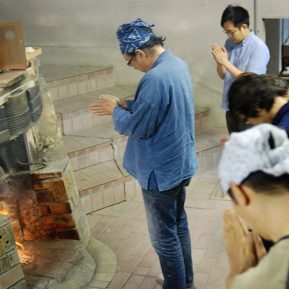Buddhist sculptor. Born in Kyoto in 1981. After graduating from high school, he studied fashion design at an art junior college and vocational school, worked as an illustrator, and began to train as a Buddhist sculptor in Kyoto. In 2015, he completed nine years of training and opened his own studio, Miyamoto-kogei, to sculpt and repair Buddhist statues.
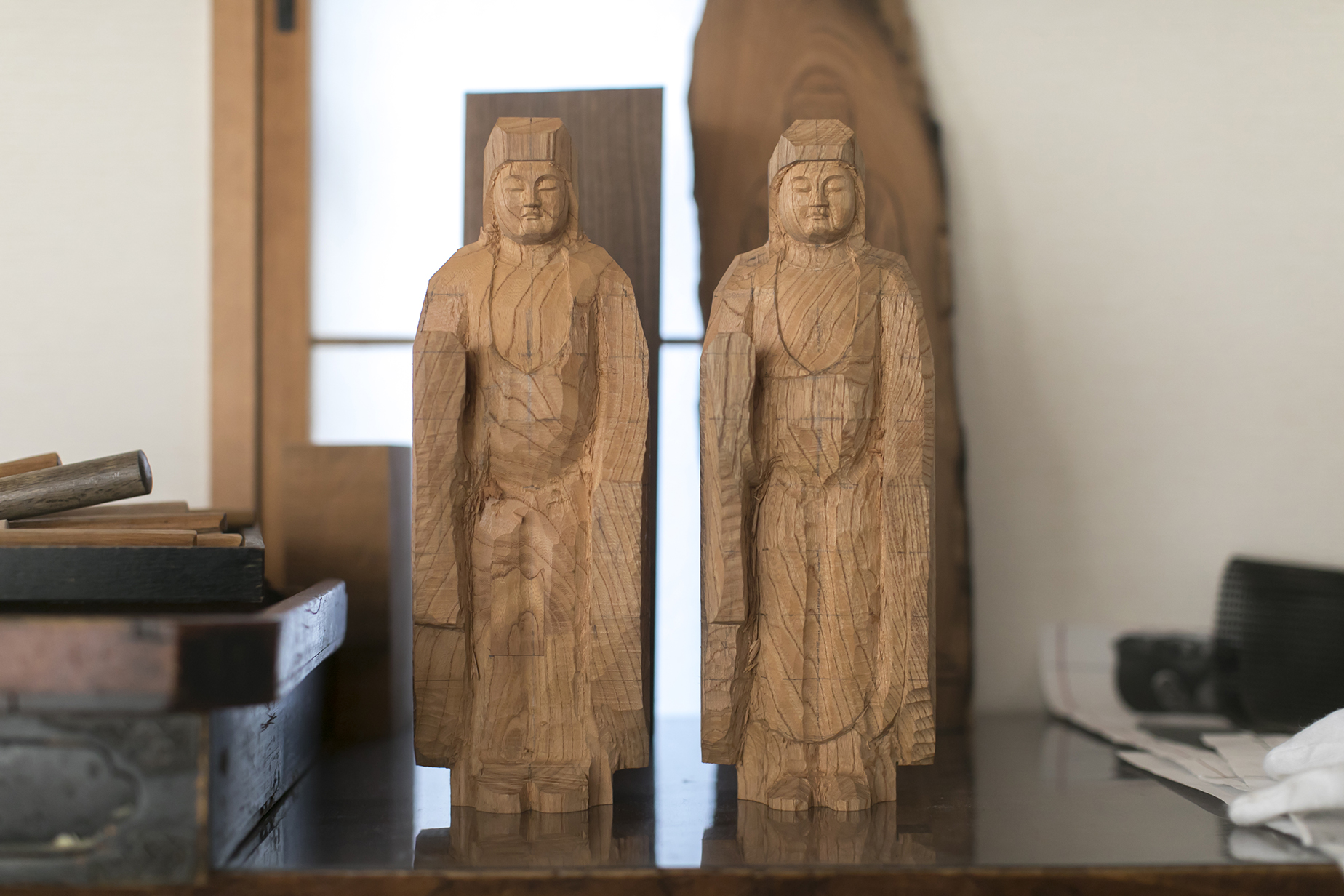
– The significance of a Buddhist sculptor
The Buddhist sculptor Gakyu Miyamoto showed us a Buddhist statue from his studio.
“This was a piece of wood that was burned completely black in a fire.”
“The home of a temple’s parishioner suffered a fire, and the head priest commissioned a statue as sympathy gift. The entire house was lost, but the central pillar made of zelkova wood remained. I carved away the surface with a chisel, and I’m just starting to see the figure of the Shaka (Buddha) inside it.”
It was zelkova wood used in a house that was over 100 years old, so perhaps the tree was over 200 years old. The surface was almost entirely carbonized in the flames, but Miyamoto says careful chiseling began to expose fresh and youthful wood little by little.
Miyamoto finished a training period of approximately nine years and left his master to become independent in 2015. This was his first commission to produce a Buddhist statue since becoming a Buddhist sculptor.
“After Miyamoto-kogei got its start, I mostly worked on sculpting projects such as ihai (Buddhist mortuary tablets) for the first year. As a Buddhist sculptor of course I wanted to create Buddhist statues, but there is an element of fate in Buddhist statue work so all I could do was wait. Creating a Buddhist statue from burned wood is unusual work, but I’m very glad that the first statue commission I got after going independent was something with strong emotional significance for the client. During the end of my training period and when I first started on my own, I continued to think about the significance of creating Buddhist statues. I was always asking myself why I was sculpting Buddhist statues, but I feel like I’m going to find that answer as I sculpt this statue.”
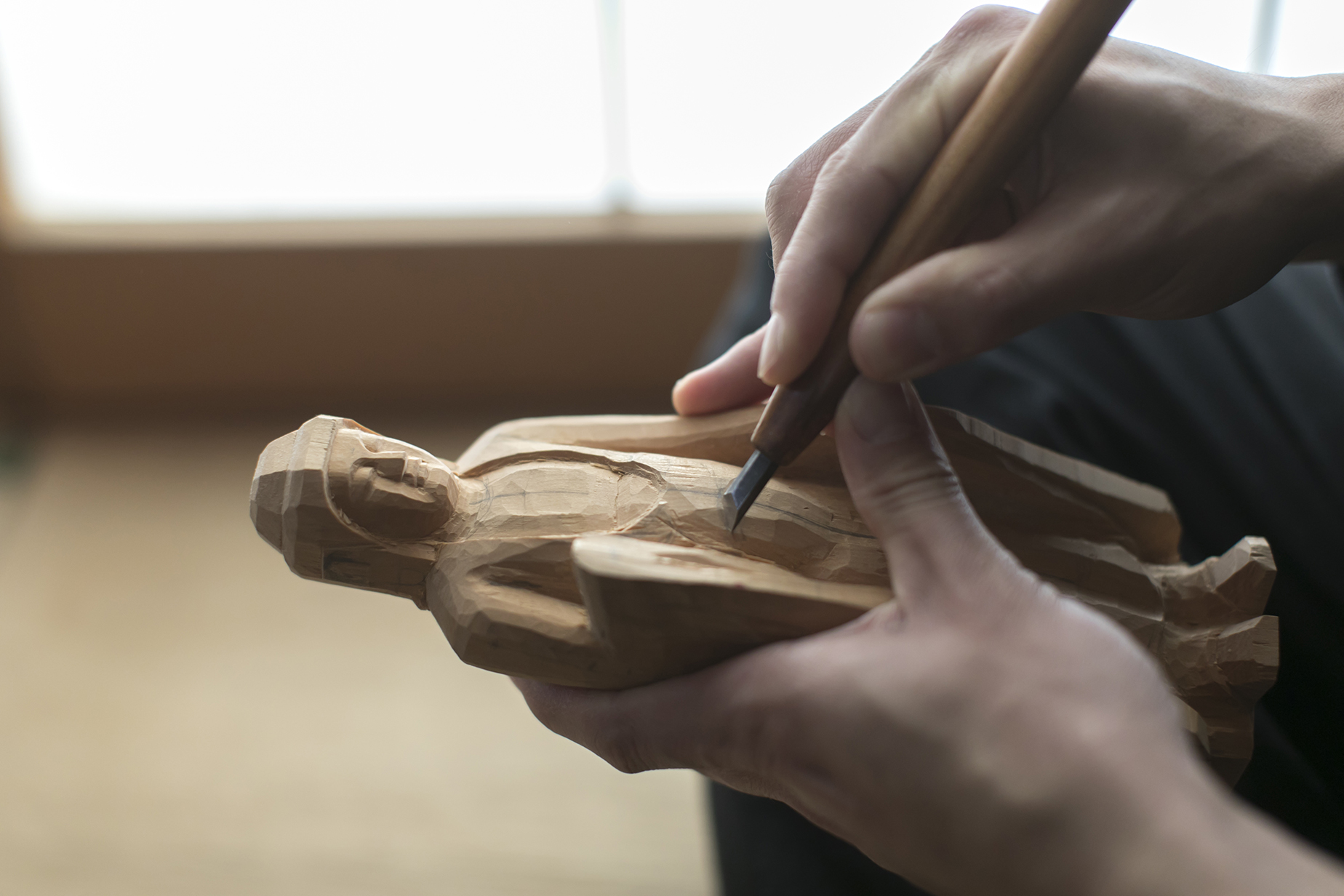
A Buddhist statue resting in Miyamoto’s hand. Each movement of the chisel carefully brings its form to life.
– Fashion and Buddhist statues
Miyamoto was born as Takayuki Miyamoto and raised in Fushimi ward in the southern part of Kyoto. What path did he take to become Gakyu Miyamoto the Buddhist sculptor?
He was always interested in fashion. In a collection of graduation essays from junior high school, the young Miyamoto wrote that he wanted to become a fashion designer. After graduating from a hometown high school, he joined the fashion design program at an art junior college. Through his study of art and fashion expression, he was captivated by design in the pursuit of the beauty of form. Upon graduation he entered a vocational design school in Tokyo as a scholarship student and was drawn even deeper into the world of fashion design.
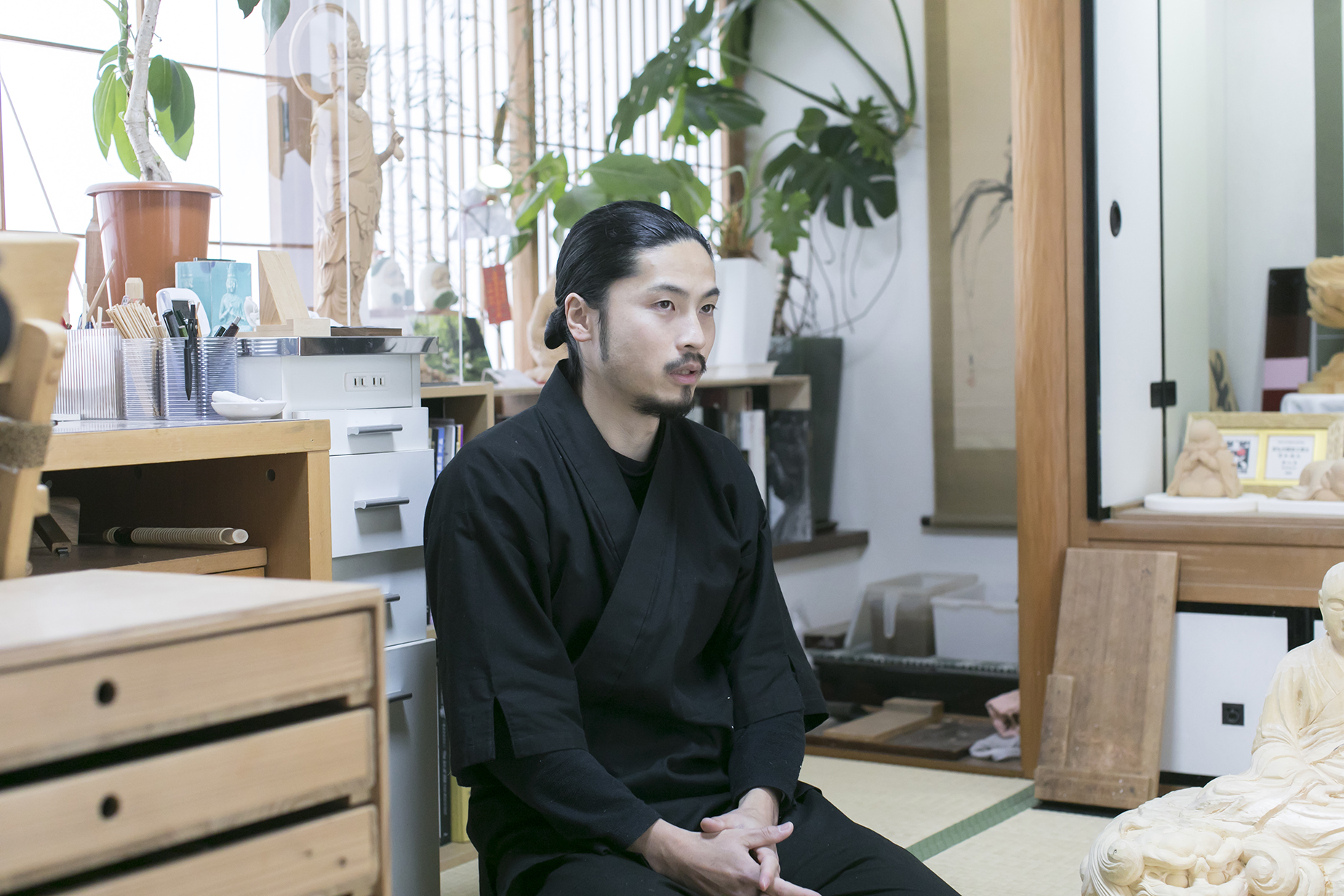
“Rather than practicality, I liked the beautiful form of clothes as a piece of art. I admired the decorative fashions coming out of European haute couture at the time, and explored approaches of my own. I wanted to be like the fashion designer John Galliano. I studied fashion for two years in junior college and three years in vocational school, but toward the end I was having more fun drawing design sketches than using the sewing machine. I ended up taking a leave of absence from vocational school to paint.”
From his start in fashion design, Miyamoto branched out into abstract paintings as he began to work vigorously to show his work at exhibits. But living in Tokyo with the pressures of part-time jobs and creating art began to take a toll on 24-year-old Miyamoto.
“I got tired and decided to move my base of operations to Kyoto, where I grew up. I worked part time at a design office while continuing to make my own work, and as I was starting to get settled in I met my master.”
It was his first time visiting a Buddhist sculptor’s studio. Brought in by his brother to help his brother’s Buddhist sculptor friend who needed an extra pair of hands, Miyamoto saw an unfinished Eleven-Faced Kannon statue standing seven shaku (approximately 2.1 meters) high. His older brother had introduced him to the master to help with painting work, one of the final hurdles remaining before its completion. Miyamoto had not been interested in Buddhist sculptures before, but he was happy to have part-time work using a painting brush. For the next six months or so, Miyamoto led a double life working in graphic design during the day and wielding a brush in front of Buddhist statues at night.

Chisels and planes. The number of tools increases as the pursuit of the ideal shape continues. Much time and effort are spent on care and maintenance as well.
“At the time, the vast difference in timeframe between the two jobs was messing with my head. On one hand you had graphic design that was consumed in the short term, and on the other hand you had the creation of objects designed to last for hundreds of years into the future. The Buddhist statue work was enjoyable and deep. I was working non-stop so my body was worn out, but I still couldn’t wait for night to come every day. At that point I couldn’t stop my feelings.”
The fashion and painting he had once been so interested in could no longer satisfy Miyamoto once he had been exposed to Buddhist sculpture.
“What had come before, and what was still to come. There was a lot to think about, but before I knew it I was bowing to my master and asking him to make me his apprentice. I was already caught up in the appeal of Buddhist sculpture.”
After thinking about it for a while, his master consented. Becoming a new apprentice at 25 years old was a late start for a craftsman.
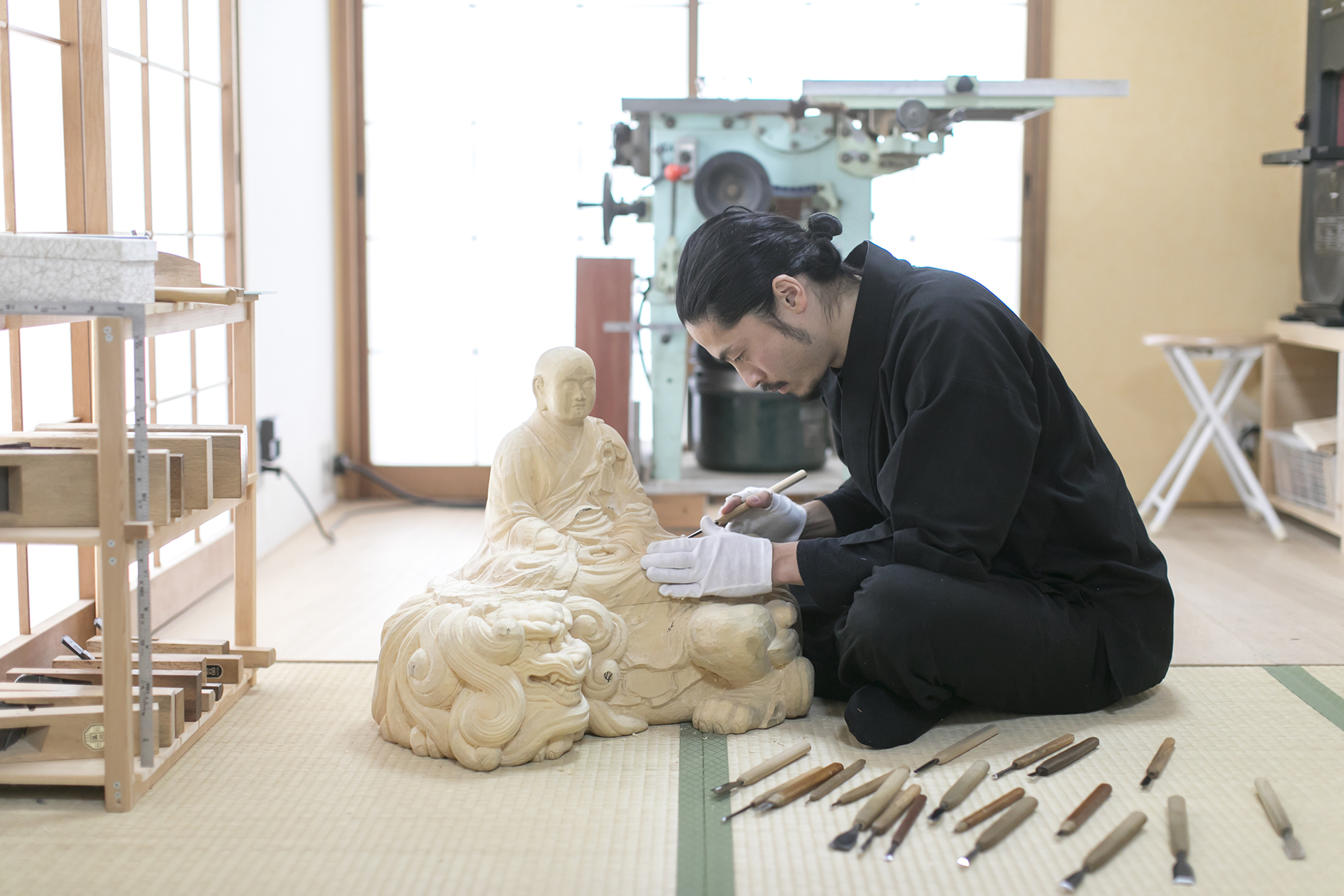
The studio’s interior seems too clean and organized to be a sculptor’s workplace.
– Luxurious training
For a Buddhist sculptor, training is demanding and long. They must learn painting, lacquering, metal leafing, and other work required to create Buddhist statues in addition to sculpting. On top of that, the repair and restoration that makes up much of a Buddhist sculptor’s work requires skills not found in creating new statues. The majority of craftsmen enter this world in their teens due to the expectation of a long training period. The age of 25, when Miyamoto began his apprenticeship, is the age when other craftsmen begin to end their training and strike out on their own as independent Buddhist sculptors.
“When you first become an apprentice, there isn’t anything you can do. It’s a helpless feeling.”
Miyamoto didn’t know how to hold a carving knife, much less how to sculpt anything. Day after day, he grew frustrated with his inability to do anything and just watched his master work.
“It was vexing to get paid by the master despite being unable to do anything. When I think about that period, the biggest thing I remember is feeling bad and wanting to apologize to my master. I didn’t know anything, so I practiced desperately at night so I could do even one more thing. One night I’d focus on a statue’s hands, or another night I’d focus just on patterns, remembering what the master had done during the day.”
Miyamoto was his master’s first apprentice. His master became a Buddhist sculptor through old-fashioned training in which nothing is taught, and the apprentice must watch the master and steal his techniques. But his master told Miyamoto, “I’ll show you all the work and answer any questions. So hurry up and improve your skills.” True to his word, he explained all of the work in detail.
“I think he took my age into consideration. To become an independent Buddhist sculptor one day, it’s best to learn skills while still young. My training was very luxurious—I would sit across from my master, and he would hand me something he carved. I would continue what he was doing and carve a little, and then he would correct what I did right in front of me. I don’t think there are many Buddhist sculptors who were lucky enough to be able to train like that. I was able to get to a certain point in nine years only because of what my master did for me.”
Because he was his master’s first apprentice, Miyamoto was fortunate enough to experience the entire range of work a Buddhist sculptor takes on. He was also able to review by taking the techniques he learned from his master and teaching them to apprentices who joined after he did. And in April of 2015, Miyamoto completed nine years of training and left his master to work on his own.

Buddhist statue parts awaiting restoration. After the washing step, they are drying in a disassembled state. Each piece is an example from the past.
– Without self
When he became independent, Miyamoto selected “Gakyu” as the name he will use as a Buddhist sculptor. The characters for “self” and “rest” combine to mean “without self” and are a warning against excessive self-assertiveness for Miyamoto, who sometimes found himself arguing with his master.
“I followed the example of Rikyu (the historical tea master) who chose his name from the Zen phrase ‘without fame or fortune’ based on the principle of living without seeking fame or fortune. A Buddhist sculptor needs to suppress his personal feelings in his work, but my opinion always comes to the surface. I chose this name so I would be reminded of the admonition every time I heard it.”
He chose a quiet residential neighborhood near Matsunoo-taisha Shrine for his combined studio and residence.
“This location is surrounded by rivers and mountains, with stable humidity throughout the year. Managing wood is an important part of a Buddhist sculptor’s job. I looked all over Kyoto for a good place and finally ended up here. Ever since I was an apprentice, I wanted to live and work in the same place. So my first big project when starting out on my own was to find a place that was well-suited to working as a Buddhist sculptor and comfortable for family life.”
The well-organized nature of the studio is striking when first entering Miyamoto-kogei. There are no tools out on the work surfaces and not a single wood shaving is on the floor.
“It bothers me when I see tools or materials left out, so I clean up whenever I have a moment. People who come here are surprised, saying ‘Do you really do any work here?’ Being well-organized is important for a craftsman, but being this thorough about it is probably just my personality.”
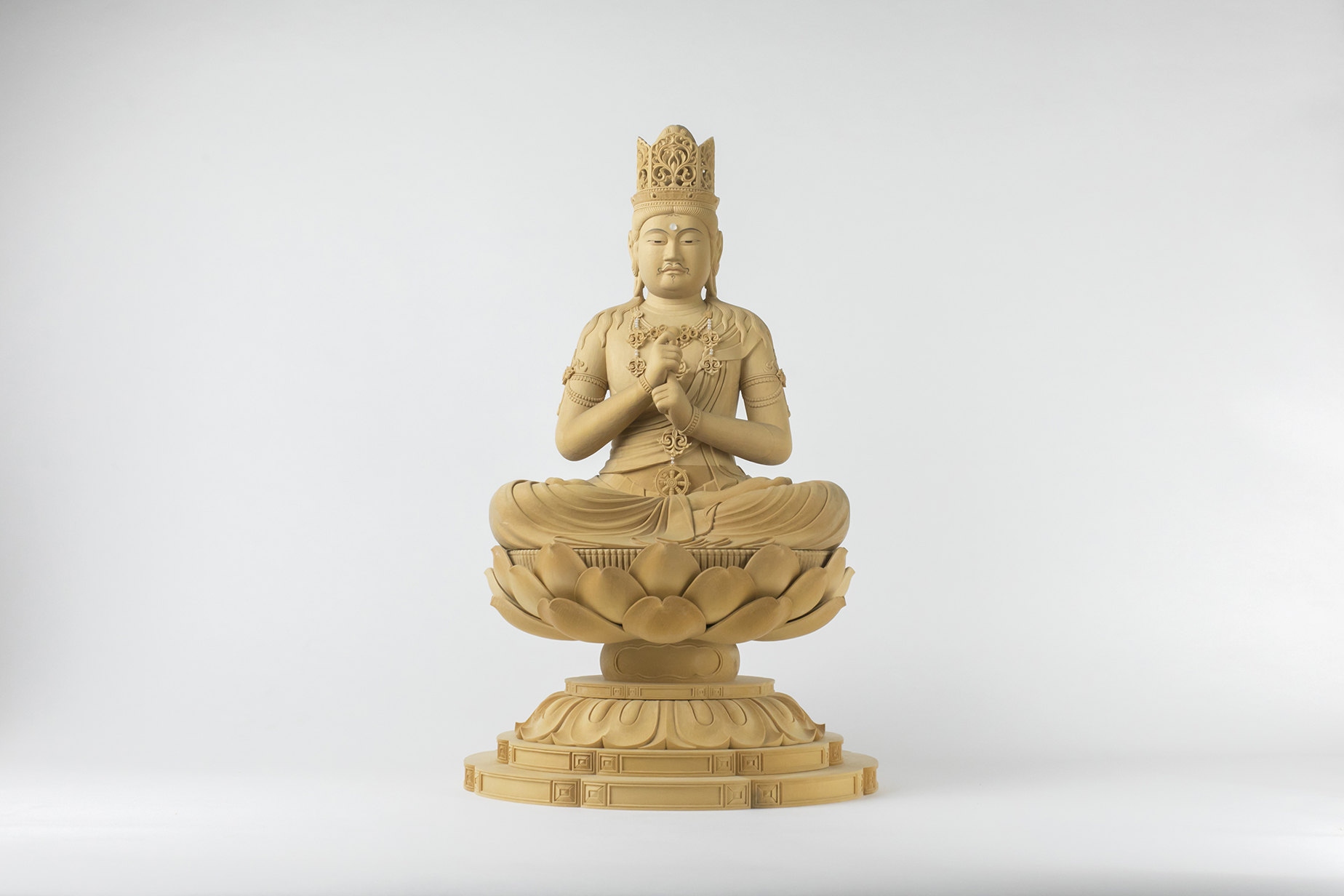
– Robe depictions of his own
Since becoming independent, Miyamoto has begun thinking about Buddhist statue depictions of his own. This led to the beauty of form from the fashion he once studied to overlap with Buddhist statues in his mind, he says.
“The way the cloth hangs from the Buddha, the folds, and the way it drapes along the body—I think it may be possible to make use of my experience with fashion design in these expressions. Buddhas are shaped like people, but they are not people. I’m hoping to depict robes with a dynamic feel as an element to highlight their solemn majesty.”
Buddhist statues are governed by rules known as “giki.” Every detail, down to the facial expression, shape of the fingers, and stance, is an embodiment of Buddhist thought. The rules exist to protect and pass on the basic forms of the past. One exception, the clothing worn by Buddhist statues, is barely mentioned in the ritual rules. As a result, there is room for Buddhist sculptors to inject their own creativity—just like actual clothing, but without undermining the sense of stateliness. Working between solemn majesty and reality, Miyamoto works to create based on the image of the Buddha in his mind.
“I thought I had been working in completely unrelated fields with fashion design, painting, and graphic design, but I was wrong. Any experience can be useful for Buddhist statues, and needs to be used. That’s what will make it mine, I think.”
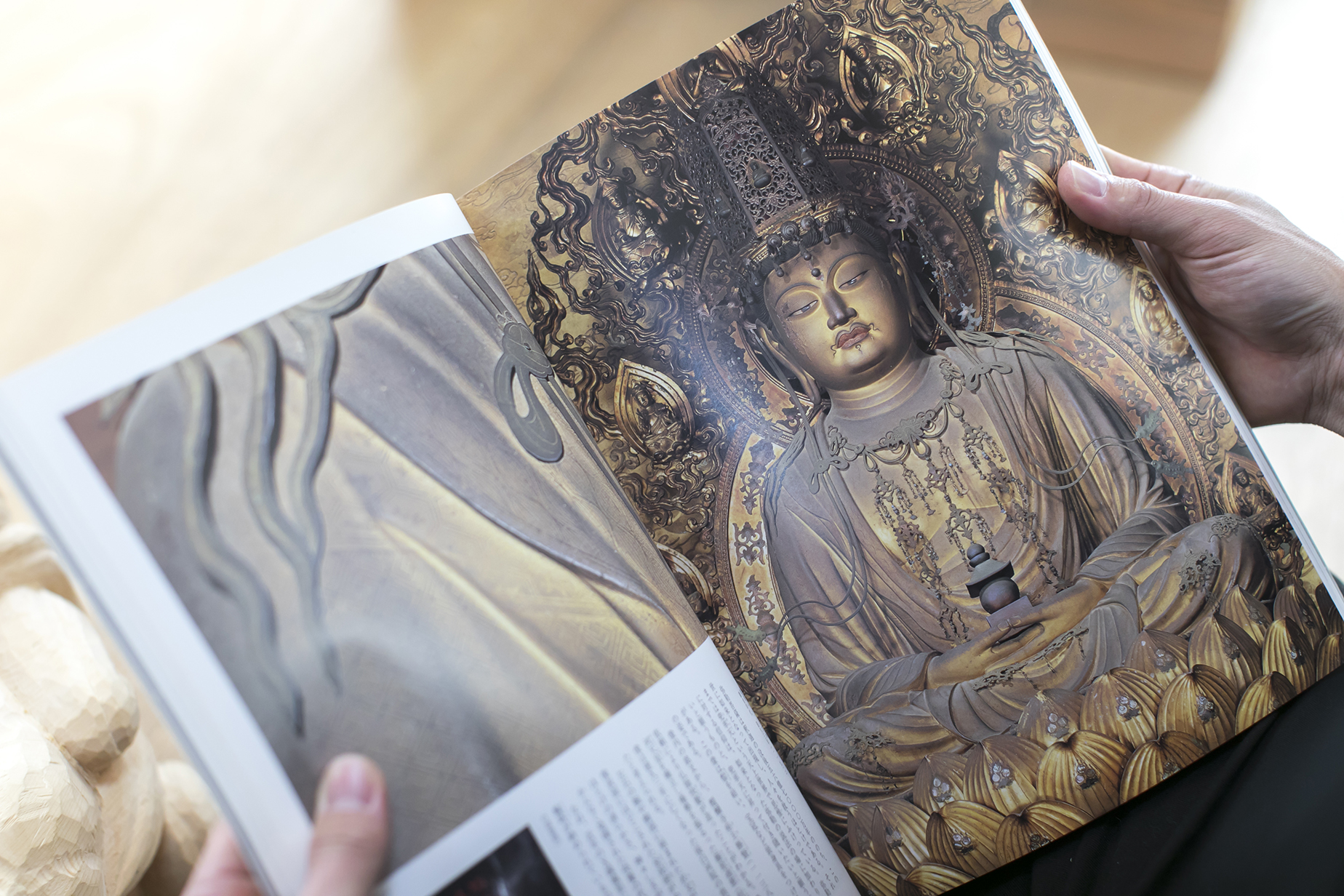
Miroku Bosatsu seated, the principal statue of Daigo-ji Sanbo-in Temple, by Kaikei.
– The work of a modern Buddhist sculptor
“Miroku Bosatsu seated, the principal statue of Daigo-ji Sanbo-in Temple.”
When asked about his ideal Buddhist statue, Miyamoto’s answer is almost instantaneous.
“Since I was an apprentice, I admired this statue more than anything. On my days off, I would often take binoculars with me to visit Daigo-ji Temple. The uniformity, lively energy, and clothing of Kaikei (a Buddhist sculptor of the Kamakura period) make it the ideal Buddhist statue in every way for me.” As he speaks, Miyamoto opens a well-worn and tattered pictorial book.
“The symmetrical positioning of the eyes and nose, and the straight nose—I believed the perfect symmetry of Kaikei’s statue was the main factor in creating a Buddhist statue’s solemn majesty, and I aimed for that ideal. But then something happened that turned that on its head.”
That event was a special museum exhibit near the end of his apprenticeship. Learning that the Miroku Bosatsu statue he had long admired would be shown, Miyamoto visited the exhibit filled with excitement and anticipation. But there, he saw a slight distortion in the form he had thought was perfect.
“The Miroku Bosatsu I saw up close for the first time wasn’t as symmetrical as I had thought. It wasn’t a big difference for most people, but it was huge for me. It had looked perfectly uniform from a distance in Daigo-ji Temple and in the pictorial book. I spent three or four hours standing in front of the Miroku Bosatsu looking up at it from below, closing one eye, and so on, but no matter what I did it wasn’t symmetrical. Up until that point, I had worked on improving my skills by believing that perfect symmetry was the key to a Buddhist statue’s beauty, but I lost sight of my goal. I felt like all the strength had drained out of my body.”
For the next year, Miyamoto was unable to sculpt Buddhist statues.
After becoming independent and with his feelings finally beginning to resolve, he received the commission to sculpt the Buddhist statue from the wood burned in the fire.
“I think my ideal image of the symmetrical Miroku Bosatsu had grown too large in my head. But symmetrical or not, the real thing far exceeded my imagination and had a godliness that can’t be expressed in words. It was an overwhelming presence that’s on an entirely different level from beauty of form. Since then, I have thought about how I can sculpt a Buddha like that.”
As Miyamoto works, a photo of Daigo-ji Temple’s Miroku Bosatsu seated statue is always placed by his side.
“Even Kaikei must have been avant-garde for his time. Rules are important, but it must be even more important to have the creativity to sculpt without being too constrained by them. When I realized that, I was even more determined to try making Buddhist statues of my own.”
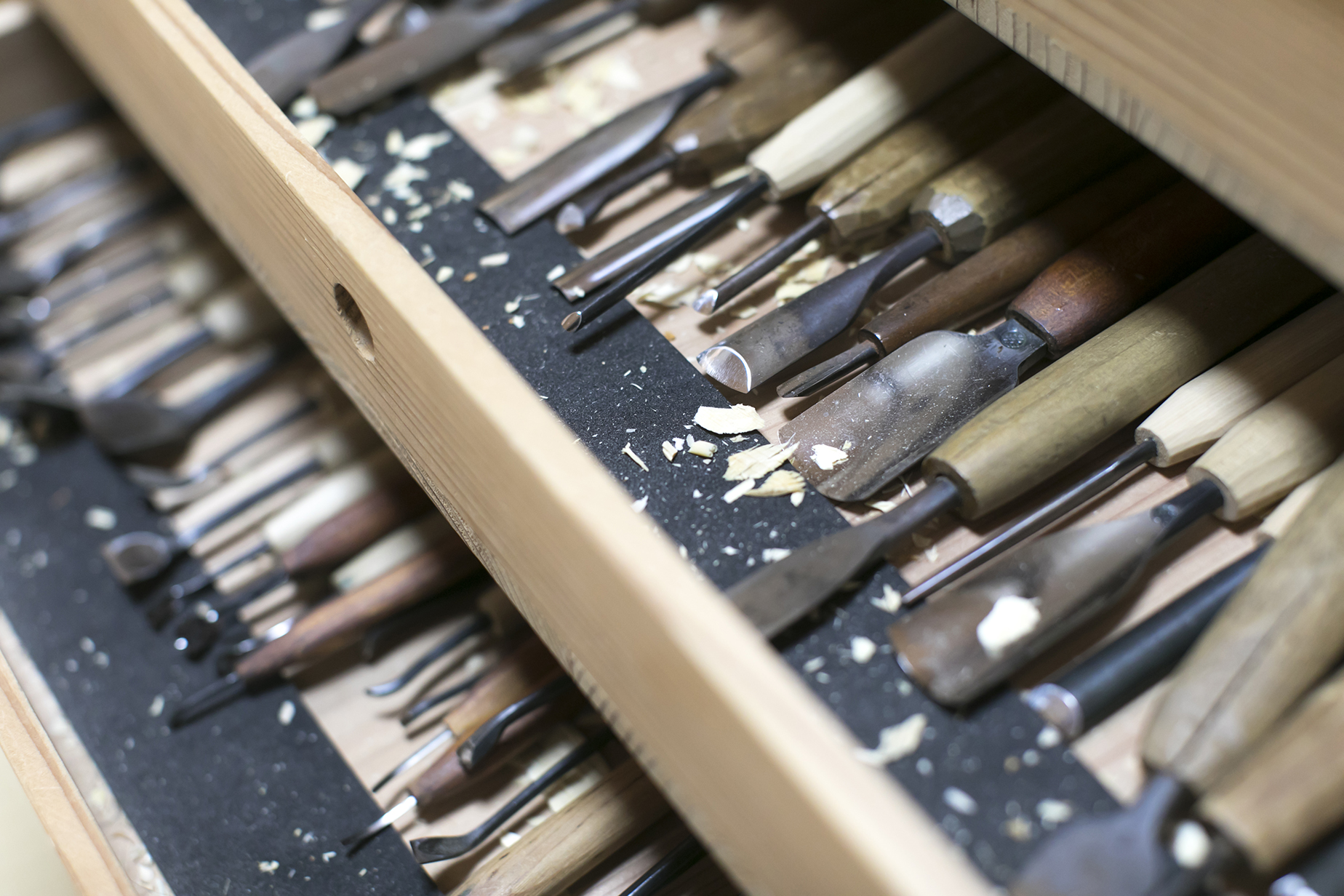
In April 2017, a Shaka Nyorai (Buddha) standing statue one shaku (approximately 33 cm) high carved from the wood burned in the fire was completed. After a production period of about one year from the order, the day of the statue’s consecration ceremony arrived. Miyamoto named the statue “Koen,” or flames of light, in the hope that the zelkova wood that withstood flames to become a Buddha would protect the family for many years to come.
“The first Buddhist statue I made as Gakyu Miyamoto became a truly invaluable experience. I feel like it taught me the significance of a job in which something I create becomes an object of worship. I felt truly blessed as a craftsman to be able to work on it.”
Miyamoto-kogei
Website: gakyu.jp/
Facebook: facebook.com/miyamotokougei/
Instagram: instagram.com/gakyu01/
SPECIAL
TEXT BY YUJI YONEHARA
PHOTOGRAPHS BY MITSUYUKI NAKAJIMA
17.08.07 MON 14:25

